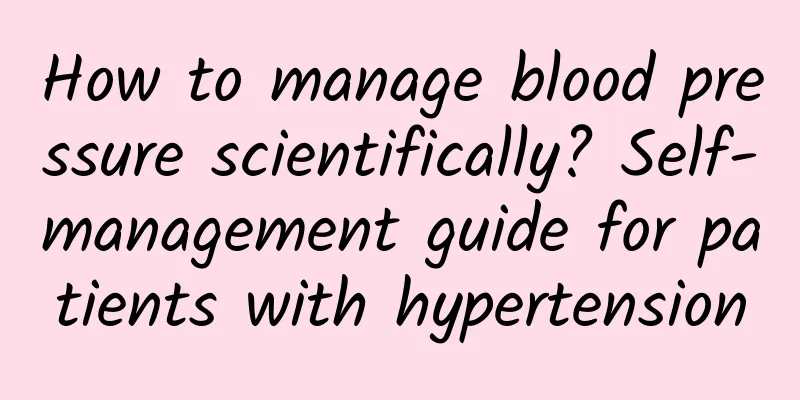How to manage blood pressure scientifically? Self-management guide for patients with hypertension

|
Hypertension is called a "silent killer" because it usually has no obvious symptoms, but long-term uncontrolled can lead to serious consequences such as cardiovascular and cerebrovascular diseases and kidney damage. According to statistics, about 1 billion people in the world suffer from hypertension, and many people do not know they are ill. This article will give you a detailed introduction on how to scientifically manage blood pressure and help patients with hypertension better control their condition. 1. What is hypertension? Definition: Blood pressure refers to the force exerted by blood on the walls of blood vessels as it flows through them. Hypertension is defined as blood pressure that is persistently higher than normal (usually systolic blood pressure ≥140 mmHg and/or diastolic blood pressure ≥90 mmHg). Classification: Essential hypertension: accounts for more than 90%, the cause is unknown, and it is related to genetics and lifestyle. Secondary hypertension: caused by other diseases (such as kidney disease, endocrine disease). Hazards: Long-term hypertension can lead to arteriosclerosis, myocardial infarction, stroke, renal failure, etc. 2. Risk Factors for Hypertension Uncontrollable factors: Age: As we age, blood vessel elasticity decreases and blood pressure tends to rise. Genetics: People with a family history of high blood pressure are at a higher risk. Controllable factors: Diet: A high-salt, high-fat diet is the main cause. Lack of exercise: Being sedentary for too long can lead to weight gain and increased blood pressure. Smoking and drinking: Nicotine and alcohol can directly increase blood pressure. Stress: Long-term mental stress can activate the sympathetic nervous system and cause blood pressure fluctuations. 3. How to manage blood pressure scientifically? Monitor your blood pressure regularly: Self-measurement of blood pressure at home: It is recommended to measure at a fixed time every day and record the data. Dynamic blood pressure monitoring: Through 24-hour dynamic blood pressure monitoring, you can understand the pattern of blood pressure fluctuations. Eat a healthy diet: Low-salt diet: Daily salt intake should be controlled below 5 grams. Eat more foods rich in potassium: such as bananas, spinach, potatoes, etc., which can help lower blood pressure. Reduce saturated fat intake: eat less red meat and fried foods, and eat more fish and nuts. Moderate exercise: Aerobic exercise: such as brisk walking, swimming, and cycling, at least 150 minutes per week. Strength training: 2 times a week to increase muscle strength and improve metabolism. Quit smoking and limit alcohol consumption: Quit smoking: Smoking causes blood vessels to constrict and blood pressure to rise. Alcohol limit: Daily alcohol intake should not exceed 25 grams for men and 15 grams for women. 1. Weight Control: BMI (body mass index) should be controlled between 18.5-24.9. Waist circumference: <90 cm for men and <85 cm for women. Psychological adjustment: Learn to relax: relieve stress through meditation, deep breathing, etc. Maintain good sleep: sleep 7-8 hours a day and avoid staying up late. |
Recommend
Premenstrual oral ulcers
Girls always face many troubles before menstruati...
Is barbecue tin foil toxic or harmful? What barbecue sauce is better?
BBQ is usually done outdoors. When people go out,...
Why is the right rear wheel brake disc of the car rusty and can't be worn off? What should I do if the right rear wheel brake disc is always rusty?
It is normal for a car's brake disc to rust. ...
Can soda water adjust the body's acid-base balance? Rumors on the June "Science Rumors List"
1. OK lenses can wear out the cornea Rumor: The e...
How many weeks is a good time to screen blood sugar?
After pregnancy, different examinations need to b...
Can pregnancy test paper detect 14 days
During the pregnancy preparation period, many cou...
Sleep time for adult women
The sleep time for adult women is about 8 hours, ...
Early symptoms of cervical precancerous lesions
It takes 6-8 years for cervical cancer to develop...
Pregnancy month to see the gender of the baby
After a woman becomes pregnant, she is very eager...
What causes low estradiol?
Under normal circumstances, the estradiol level i...
Which panel of gas stove has good quality? How to improve the thermal efficiency of gas stove
Gas stoves are low-cost, cost-effective, diverse ...
Can an air fryer make mooncakes? What is mooncake premix?
Mooncakes come in many varieties. Based on the co...
Why does it hurt every time I pee after sex?
If a man experiences pain or a little redness in ...
Is McDonald's Alexander Wang Black Gold Bucket delicious? How does McDonald's Alexander Wang Black Gold Bucket taste?
We all know that McDonald's launches new flav...
Please keep this medicine kit when you are traveling
For long-distance travel, you can bring vitamin C...









